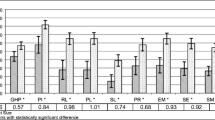Abstract
Purpose
Psychometric evaluation with tools such as the faecal incontinence quality of life scale is an essential component of clinical assessment. Currently, there is no translated Traditional Chinese version of the scale. A validated translated version may help to improve the quality of healthcare received in countries with Chinese minorities (0.5, 1.2 and 4.0 % of the UK, USA and Australian population, respectively) as well as local population of Hong Kong. The purpose of this study is to validate the Traditional Chinese version of the faecal incontinence quality of life scale (FIQL).
Methods
The FIQL questionnaire was translated into Traditional Chinese Language followed by linguistic validation. It was then tested on 55 patients with faecal incontinence and 93 controls in the colorectal outpatients clinic. Faecal incontinence severity index was also used for the assessment of disease severity.
Results
Internal consistency was good/excellent for all scales (Cronbach’s alpha >0.70, between 0.71 and 0.93). The intra-class correlation indicated a high stability over time with coefficients ranging between 0.78 and 0.90. Test and retest of all four scales found no significant differences of mean scores between baseline and retest. The mean faecal incontinence quality of life scale scores of all four domains improved significantly after treatment of 10 patients whose faecal incontinence severity index scores decreased by 50 % of their pre-treatment scores, hence indicating good sensitivity.
Conclusions
This study demonstrates the linguistic and psychometric validity of the traditional Chinese version of the faecal incontinence quality of life scale.


Similar content being viewed by others
References
Barker A, Hurley J (2014) Novel treatment options for fecal incontinence. Clin in Colon Rectal Surg 27:116–20
Erekson EA, Ciarleglio MM, Hanissian PD et al (2014) Functional disability among older women with fecal incontinence. Am J of Obs and Gynae 327:e1–7, March
Jorge JM, Wexner SD (1993) Etiology and management of fecal incontinence. Dis Colon Rectum 36:77–97
Vaizey CJ, Carapeti E, Cahill JA, Kamm MA (1993) Prospective comparison of faecal incontinence grading systems. Gut 44:77–80
Rockwood TH, Church JM, Fleshman JW et al (1999) Patient and surgeon ranking of the severity of symptoms associated with fecal incontinence: the fecal incontinence severity index. Dis Colon Rectum 42:1525–32
Rockwood TH, Church JM, Fleshman JW et al (2000) Fecal Incontinence Quality of Life Scale: quality of life instrument for patients with fecal incontinence. Dis Colon Rectum 43:9–16
Rullier E, Zerbib F, Marrel A et al (2004) Validation of the French version of the Fecal Incontinence Quality-of-Life (FIQL) scale. Gastroenterol Clin Biol 28:562–8
Dehli T, Martinussen M, Mevik K et al (2011) Translation and validation of the Norwegian version of the fecal incontinence quality-of-life scale. Scand j surg : SJS : official organ for the Finnish Surgical Society and the Scandinavian Surgical Society 100:190–5
Altomare DF, Rinaldi M, Giardiello GG et al (2005) Italian translation and prospective validation of fecal incontinence quality of life (FIQL) index. Chir Ital 57:153–8
Ogata H, Mimura T, Hanazaki K (2012) Validation study of the Japanese version of the Faecal Incontinence Quality of Life Scale. Colorectal dis : the official journal of the Association of Coloproctology of Great Britain and Ireland 14:194–9
Dedeli O, Fadiloglu C, Bor S (2009) Validity and reliability of a Turkish version of the Fecal Incontinence Quality of Life Scale. J wound, ostomy, continence nurs : official publication of The Wound, Ostomy and Continence Nurses Society / WOCN 36:532–8
Minguez M, Garrigues V, Soria MJ et al (2006) Adaptation to Spanish language and validation of the fecal incontinence quality of life scale. Dis Colon Rectum 49:490–9
Lam CL, Tse EY, Gandek B, Fong DY (2005) The SF-36 summary scales were valid, reliable, and equivalent in a Chinese population. J Clin Epidemiol 58:815–22
Cronbach LJ (1951) Coefficient alpha and the internal structure of tests. Psychometrika 16:297–334
Mak TWC, Ngo DKY, Leung WW et al (2014) A pilot study to investigate the efficacy of transcutaneous electric nerve stimulation on acupoints (Acu-TENS) for the treatment of faecal incontinence. Colorectal dis : the official journal of the Association of Coloproctology of Great Britain and Ireland 16:204–8
Yusuf SA, Jorge JM, Habr-Gama A et al (2004) Evaluation of quality of life in anal incontinence: validation of the questionnaire FIQL (Fecal Incontinence Quality of Life). Arq Gastroenterol 41:202–8
Tsunoda A, Yamada K, Kano N, Takano M (2013) Translation and validation of the Japanese version of the fecal incontinence quality of life scale. Surg Today 43:1103–8
Peyre H, Leplege A, Coste J (2011) Missing data methods for dealing with missing items in quality of life questionnaires. A comparison by simulation of personal mean score, full information maximum likelihood, multiple imputation, and hot deck techniques applied to the SF-36 in the French 2003 decennial health survey. Qual life res : an international journal of quality of life aspects of treatment, care and rehabilitation 20:287–300
Author information
Authors and Affiliations
Corresponding authors
Rights and permissions
About this article
Cite this article
Mak, T.W.C., Leung, W.W., Ngo, D.K.Y. et al. Translation and validation of the traditional Chinese version of the faecal incontinence quality of life scale. Int J Colorectal Dis 31, 445–450 (2016). https://doi.org/10.1007/s00384-015-2462-9
Accepted:
Published:
Issue Date:
DOI: https://doi.org/10.1007/s00384-015-2462-9




